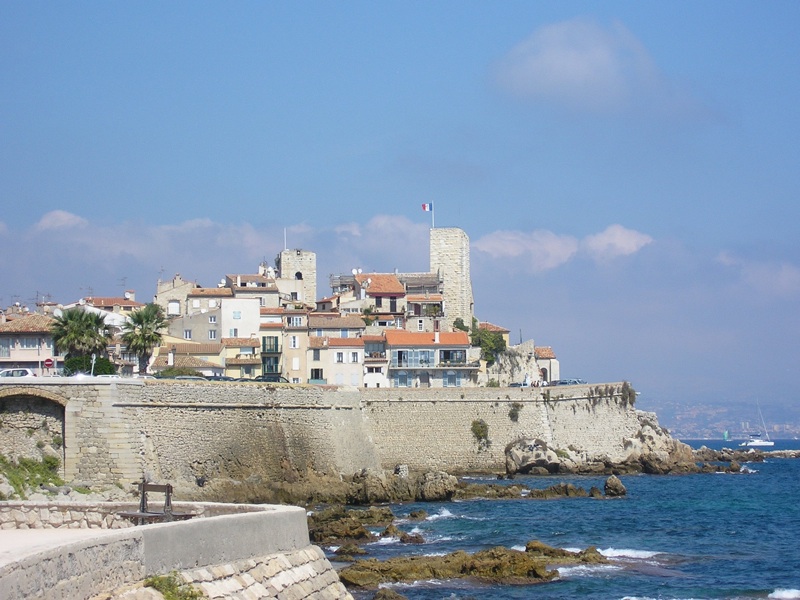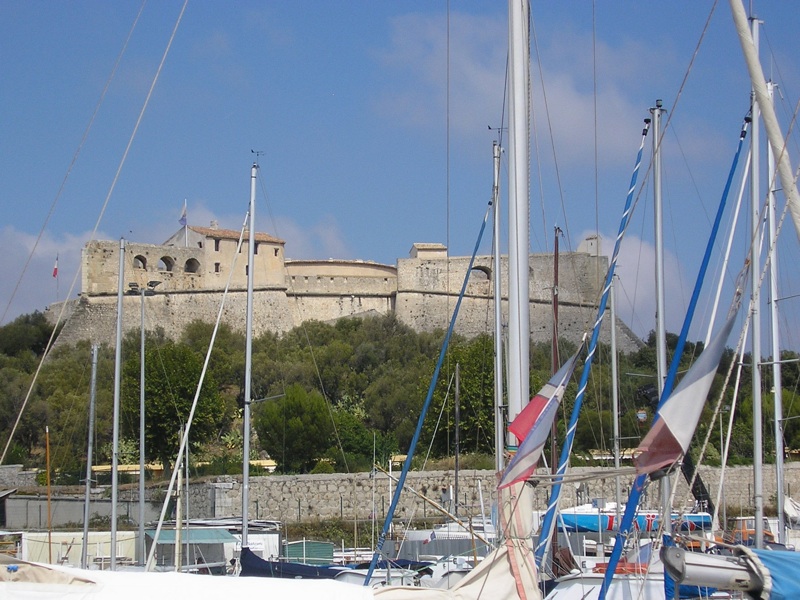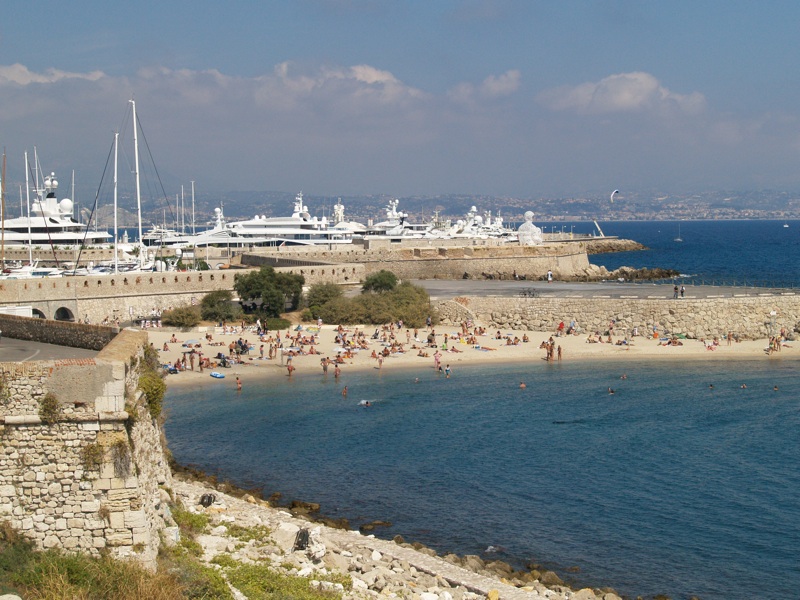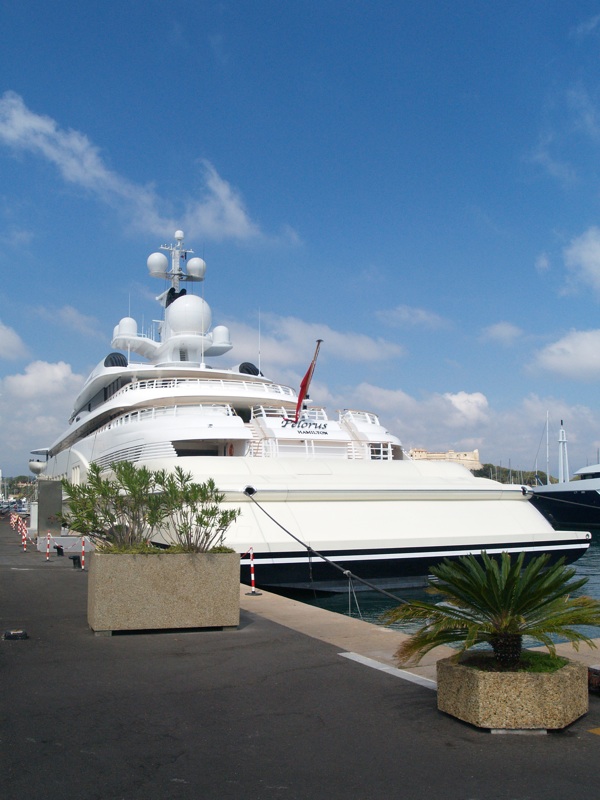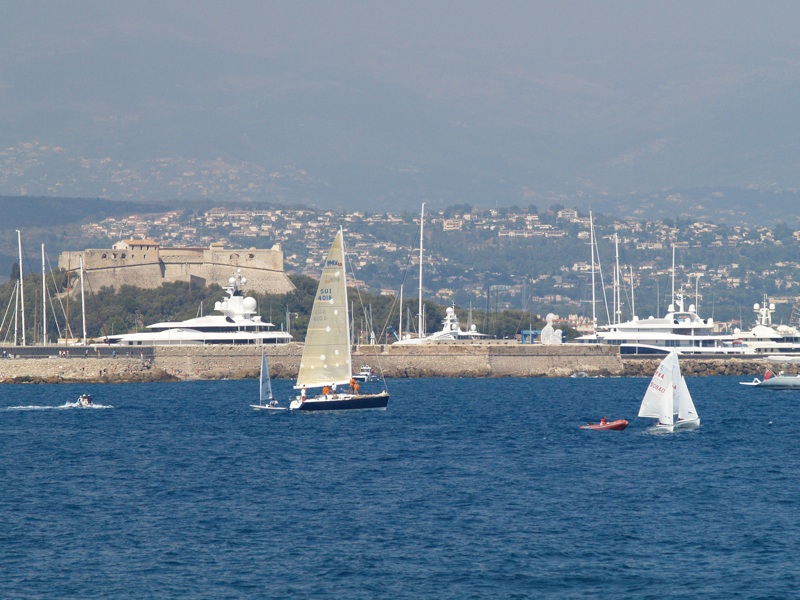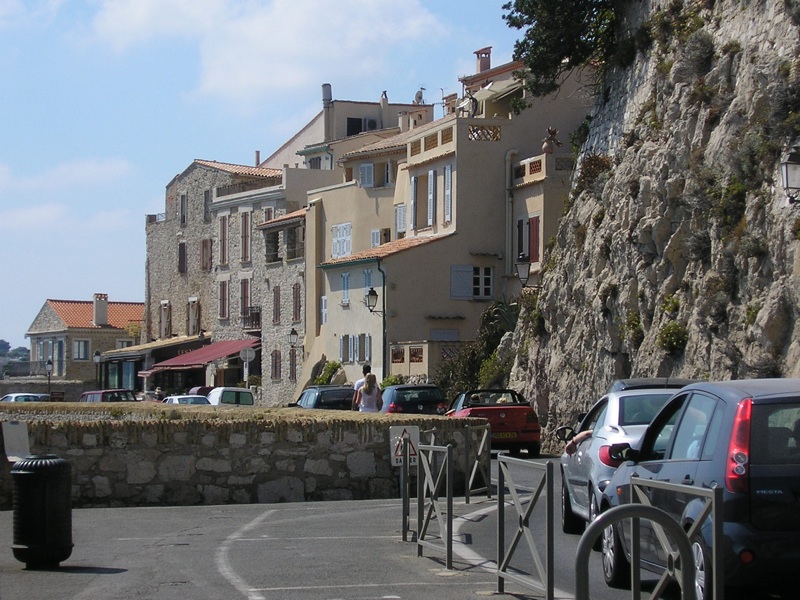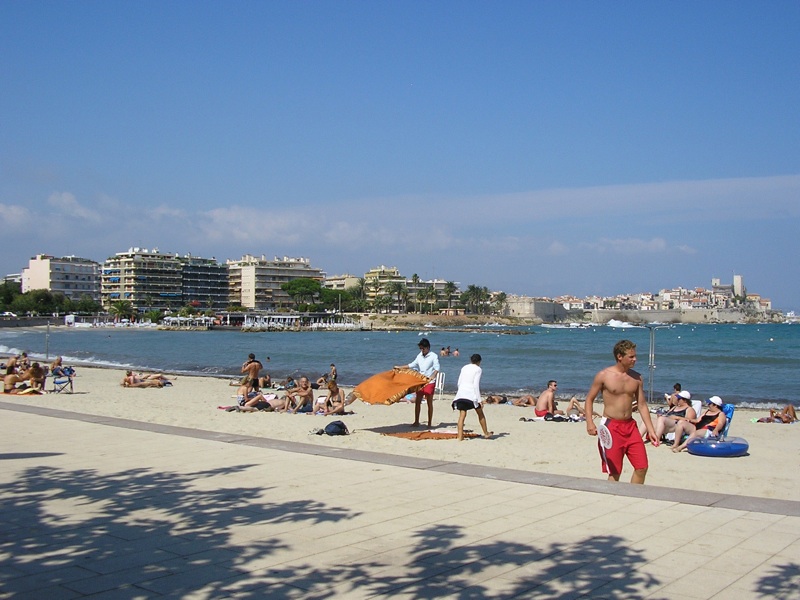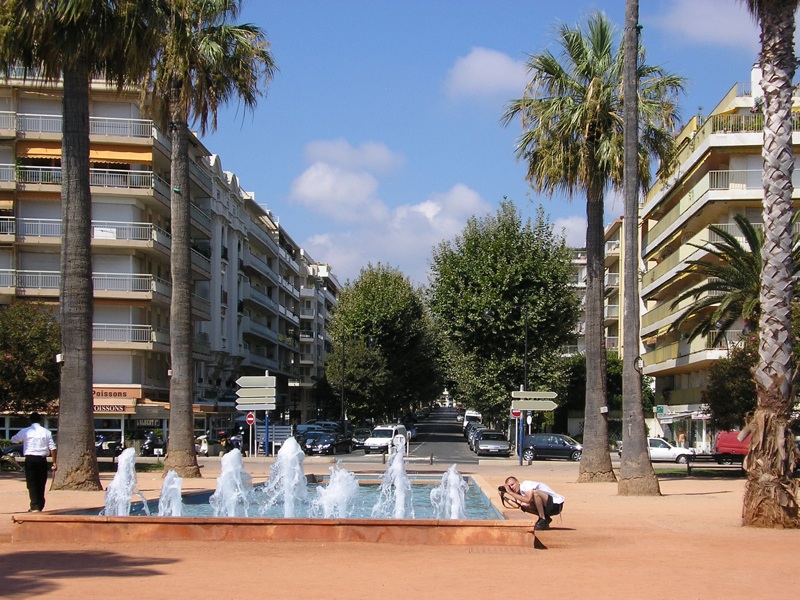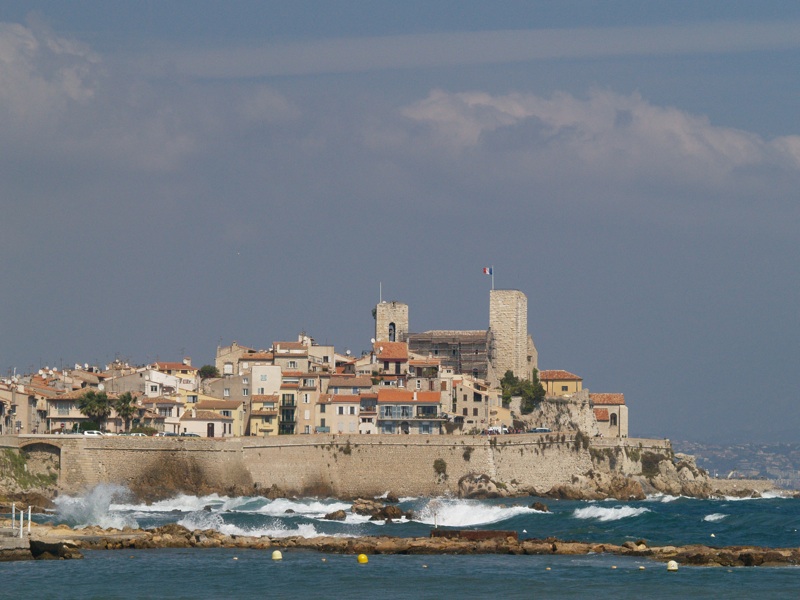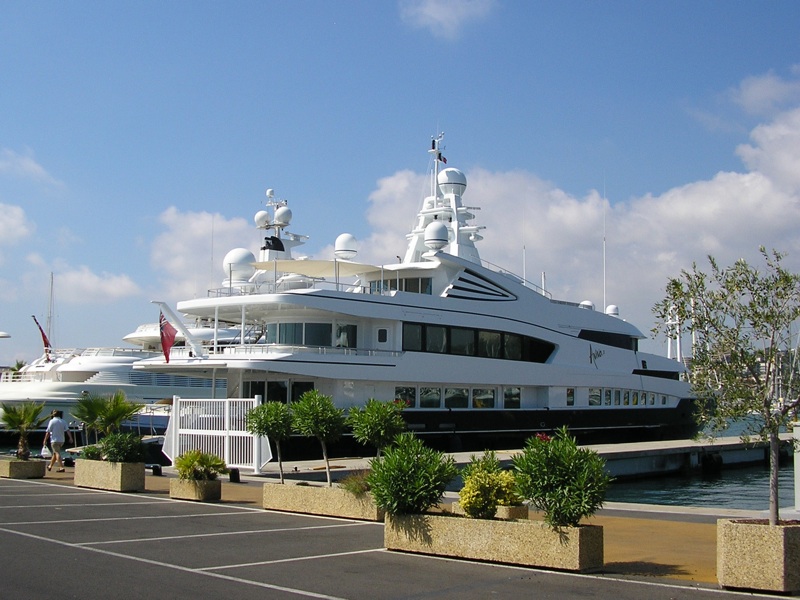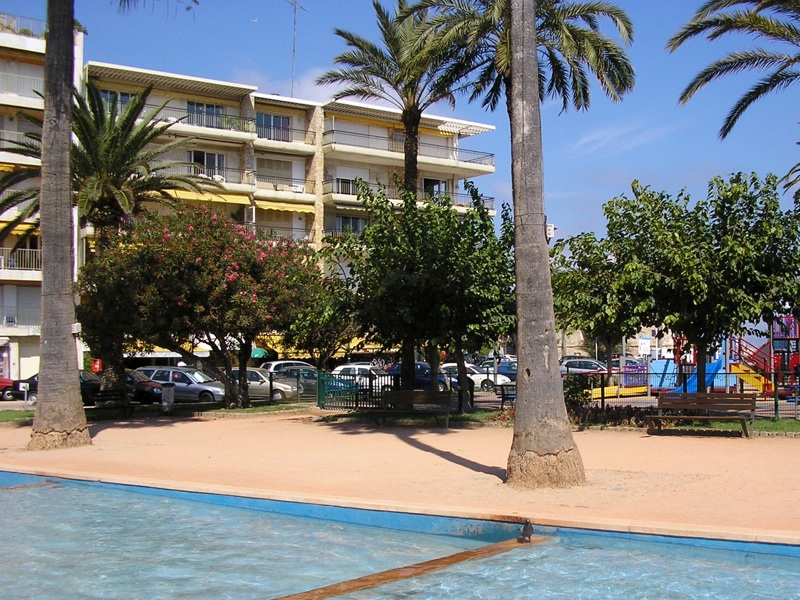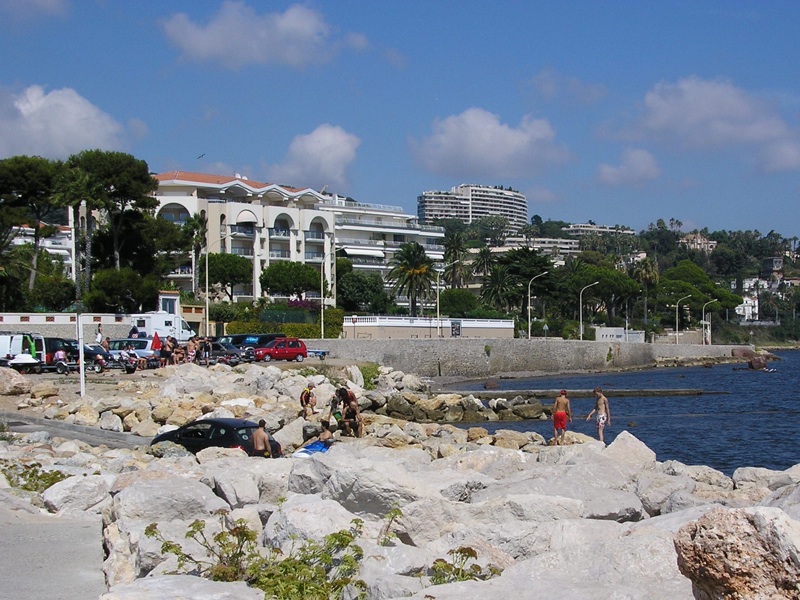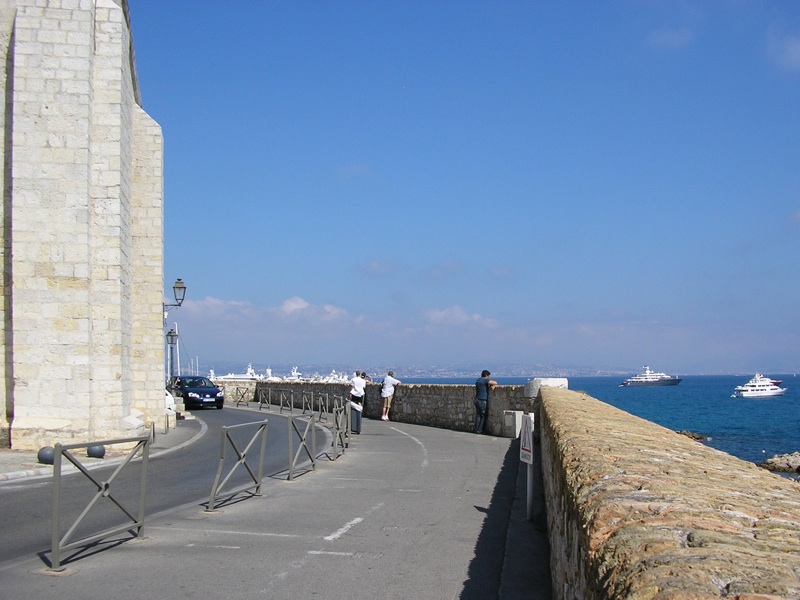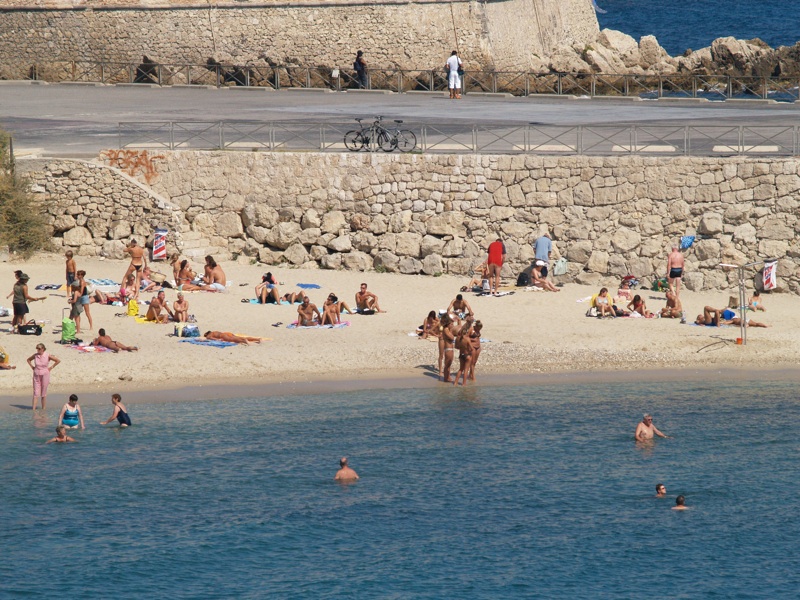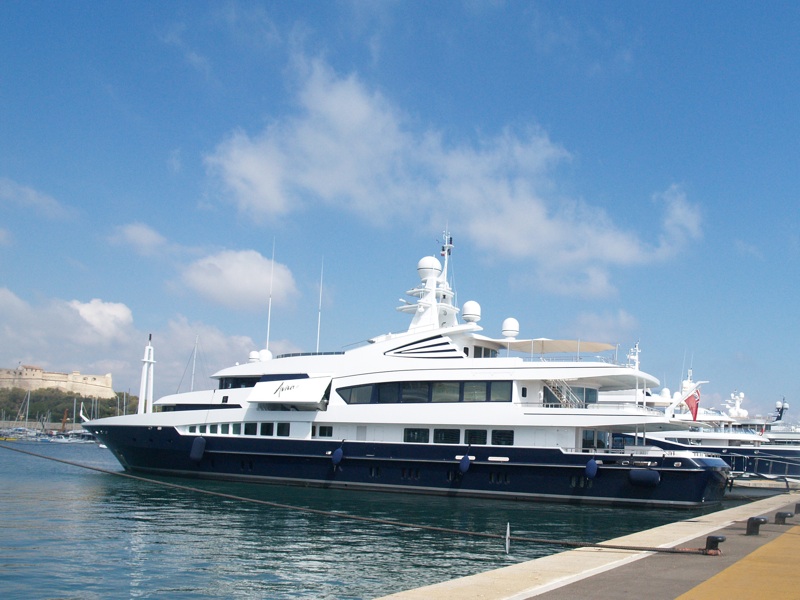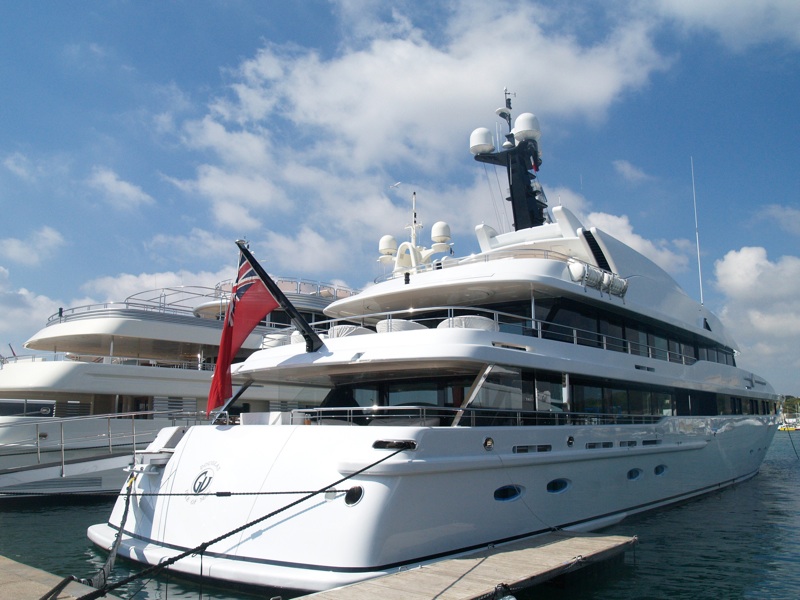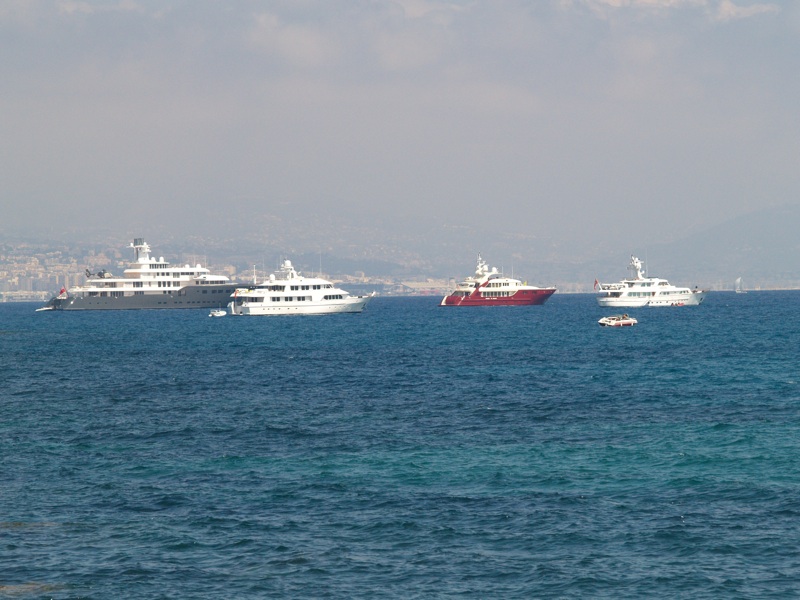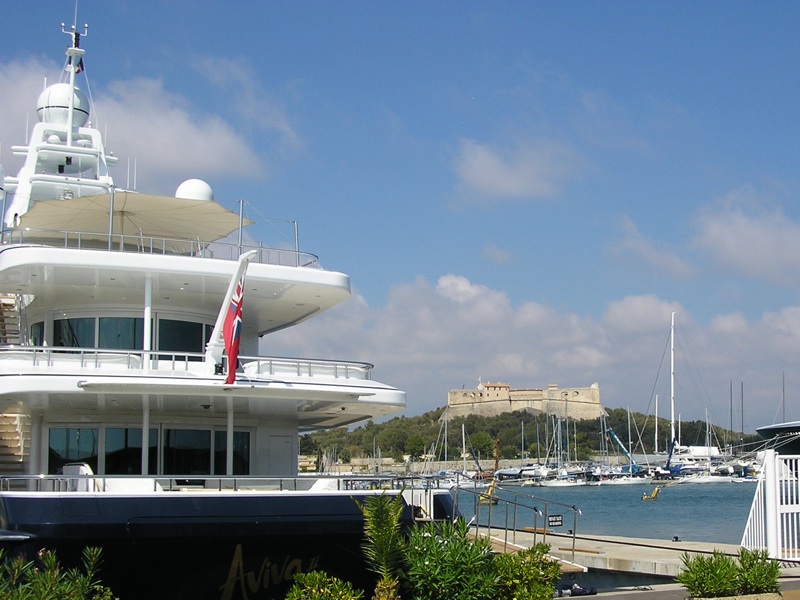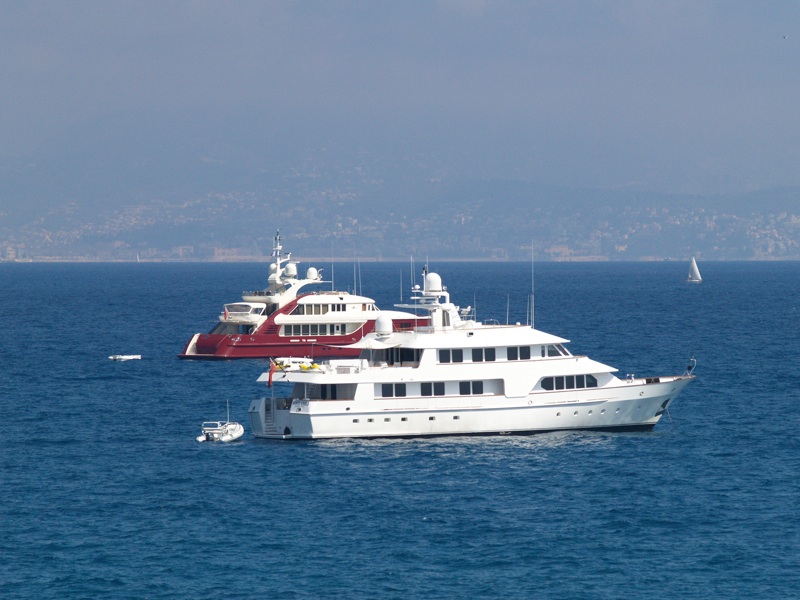Photo gallery
 , about 13 km east of Cannes
, about 13 km east of Cannes  (➤ map)(➤ map). A well-known resort and recreation center at the base of the Cap d'Antibes peninsula, facing the bay called "la Baie des Anges" - closed from the east by the coastal boulevards of Nice. It is famous for the largest yachting harbour in Europe.
(➤ map)(➤ map). A well-known resort and recreation center at the base of the Cap d'Antibes peninsula, facing the bay called "la Baie des Anges" - closed from the east by the coastal boulevards of Nice. It is famous for the largest yachting harbour in Europe.The city - named Antipolis (Ἀντίπολις) - was founded in the 5th or 4th century BC by Greeks from Phocaea who previously founded Marseille. In the 1st century BC, after the capture of Marseille by the Romans, Antibes also fell into their hands and was for a long time the largest city in the region, a commercial center and the main port of Gallia Narbonensis. After the fall of the Roman Empire, Antibes passed from hand to hand, gradually losing its importance.
From the end of the 14th century to the beginning of the 17th century, the city remained under the rule of the Grimaldi (the castle, Château Grimaldi, visible from almost every point of the seaside promenade, is from this period). When in 1388 Nice was detached from Provence (going under the rule of Savoy), Antibes became a border town, requiring the strengthening of previously built fortifications - this became especially important during the so-called the Italian wars (conducted in the years 1494-1559 with the participation of most of the then important European countries and states). In 1608, the city was taken over from the Grimaldi (who then moved to Cagnes-sur-Mer) by Henry IV, the first king of France from the Bourbon dynasty. Under Louis XIV, the port of Antibes and the city's fortifications were rebuilt by the famous military engineer, Sébastien le Prestre de Vauban; defensive walls surrounding the old town, the so-called Fort Carré
 (built in the second half of the 16th century, rebuilt by Vauban) and the so-called bastion of St. Andrew
(built in the second half of the 16th century, rebuilt by Vauban) and the so-called bastion of St. Andrew  , survived to this day.
, survived to this day.From around the middle of the 19th century, Antibes, like many other towns on the Côte d'Azur, began to attract the attention of artists, but also of the aristocracy and representatives of Europe's financial elite of the time, who began to spend their holidays here or buy properties.
In 1926, the city took over the former Grimaldi Castle
 and turned it into a museum. In 1946, part of the castle housed Picasso's studio for several months, made available to the artist by the municipal authorities; in return, Picasso left in Antibes the works he created at that time.
and turned it into a museum. In 1946, part of the castle housed Picasso's studio for several months, made available to the artist by the municipal authorities; in return, Picasso left in Antibes the works he created at that time.Today, Antibes is one of the trendiest - and most expensive - resorts on the Côte d'Azur. Almost the entire Cap d'Antibes peninsula is in private hands - the residences rival the palaces and villas located on another famous peninsula - Cap Ferrat, and the port of Antibes
 (sometimes called the "port of billionaires"), in terms of the size and value of the yachts moored there, it is probably unmatched in the entire Mediterranean.
(sometimes called the "port of billionaires"), in terms of the size and value of the yachts moored there, it is probably unmatched in the entire Mediterranean.- picturesque old town (centred around the Cours Masséna, where the famous Provençal market is held, specializing especially in herbs and fragrance oils);
- the defensive walls surrounding the old city and other remains of fortifications, including the aforementioned Fort Carré
 and bastion of St. Andrew
and bastion of St. Andrew  (Bastion St.-André);
(Bastion St.-André);
- remains of Grimaldi Castle
 from the 13th-16th century - currently the seat of the Picasso Museum;
from the 13th-16th century - currently the seat of the Picasso Museum;
- standing right next to the castle, erected on the site of a former Greek temple, a church known as Église d'Immaculée Conception or Notre-Dame-de-la-Platea d'Antibes
 , with a preserved Romanesque bell tower from the 12th century, which also served as a city watchtower;
, with a preserved Romanesque bell tower from the 12th century, which also served as a city watchtower;
- Port Vauban
 - the largest yachting harbour in Europe.
- the largest yachting harbour in Europe.
Cathédrale Notre-Dame-de-la-Platea d'Antibes
- From the 4th century to 1244, Antibes was the seat of a bishopric (later moved to Grasse), and the above-mentioned church served as a cathedral (which was destroyed by the Saracens in 1124, but rebuilt the following year. The façade of the temple dates back to the 17th century; portal made of oak wood (with figures of St. Roch and St. Sebastian, patrons of the city) - from the beginning of the 18th century. Inside, it is worth noting, among others, a wooden crucifix from the mid-15th century and on the Notre-Dame-du-Rosaire retable from the early 16th century. The church, famous for its excellent acoustics, hosts a festival of sacred music every January.
Port Vauban
The main port of Antibes  , rebuilt in the 17th century by Vauban and named "le port Vauban", with 2,000 berths, capable of accepting yachts with a length exceeding 100 m, it is considered the largest and most elite yacht port in Europe. At the "billionaires wharf" ("quai des milliardaires") you can see the Octopus yacht owned by Paul Allen, co-founder of Microsoft, Octopus, the Lady Moura yacht, belonging to the Saudi prince Nasser al-Rashid, yachts of the Russian oligarch, Roman Abramovich, otherwise the owner of one of the estates on the Cap d'Antibes peninsula, Château de la Croë (in the photo, one of Abramowicz's yachts, Pelorus), Indian Empress - the yacht of an Indian rich man named Vijay Mallya, the famous yacht Phocéa, owned by a French billionaire of Lebanese descent, ex-wife of the aforementioned Nasser al-Rashid, Mouna Ayoub (who bought him from Bernard Tapie) - and other units of this class.
, rebuilt in the 17th century by Vauban and named "le port Vauban", with 2,000 berths, capable of accepting yachts with a length exceeding 100 m, it is considered the largest and most elite yacht port in Europe. At the "billionaires wharf" ("quai des milliardaires") you can see the Octopus yacht owned by Paul Allen, co-founder of Microsoft, Octopus, the Lady Moura yacht, belonging to the Saudi prince Nasser al-Rashid, yachts of the Russian oligarch, Roman Abramovich, otherwise the owner of one of the estates on the Cap d'Antibes peninsula, Château de la Croë (in the photo, one of Abramowicz's yachts, Pelorus), Indian Empress - the yacht of an Indian rich man named Vijay Mallya, the famous yacht Phocéa, owned by a French billionaire of Lebanese descent, ex-wife of the aforementioned Nasser al-Rashid, Mouna Ayoub (who bought him from Bernard Tapie) - and other units of this class.Museums in Antibes
There are several museums worth visiting in Antibes, two of which are considered particularly interesting: the Picasso Museum and the Archaeological Museum.
- The Picasso Museum (Musée Picasso) is located in the Grimaldi Castle
 . It has one of the world's largest collections of works by Picasso (about 250 works), including paintings, drawings, sculptures, ceramics (also made in Poterie Madoura in Vallauris); In addition, you can admire the works of art in the museum. artists such as Max Ernst, Joan Miró, Fernand Léger and Nicolas de Staël.
. It has one of the world's largest collections of works by Picasso (about 250 works), including paintings, drawings, sculptures, ceramics (also made in Poterie Madoura in Vallauris); In addition, you can admire the works of art in the museum. artists such as Max Ernst, Joan Miró, Fernand Léger and Nicolas de Staël.
- The Archaeological Museum (Musée d'Histoire et d'Archéologie) is housed in the bastion of St. Andrew
 (Bastion Saint-André), a fortress built by Vauban in the late 17th century. The collections mainly include works of Greek and Etruscan art (vases, amphoras, etc.), excavated from shipwrecks or from the bottom of the Mediterranean Sea. From the promenade by the museum, you can enjoy particularly beautiful views of the coast, with the Maritime Alps in the background.
(Bastion Saint-André), a fortress built by Vauban in the late 17th century. The collections mainly include works of Greek and Etruscan art (vases, amphoras, etc.), excavated from shipwrecks or from the bottom of the Mediterranean Sea. From the promenade by the museum, you can enjoy particularly beautiful views of the coast, with the Maritime Alps in the background.
Antibes area
- While in Antibes, it is worth going south, towards the cape. Most of the peninsula (and the Plateau de la Garoupe that covers much of it) is in private hands; however, you can drive to the lighthouse (Phare de la Garoupe
 ) and the Notre-Dame de la Garoupe chapel nearby, from which there is a vast view. A small maritime museum is also worth visiting
) and the Notre-Dame de la Garoupe chapel nearby, from which there is a vast view. A small maritime museum is also worth visiting  . Be sure to also see Juan-les-Pins
. Be sure to also see Juan-les-Pins  , belonging to the municipality of Antibes a seaside resort on the western side of the peninsula, famous for its beautiful 2-kilometre long sandy beach and the annual jazz festival.
, belonging to the municipality of Antibes a seaside resort on the western side of the peninsula, famous for its beautiful 2-kilometre long sandy beach and the annual jazz festival.
Additional information
- Every April, the famous "Antibes Yacht Show" takes place in the main port of Antibes; while the beginning of June is the date of one of the largest and most prestigious annual sailing events in the Mediterranean: the season-opening regatta of ancient yachts called "Les Voiles d'Antibes - Trophée Panerai".
- Antibes boasts a very long list of famous people who were associated with the city in one way or another. Included on this list are Napoleon Bonaparte (who in 1794, then appointed commander of the coast guard general, moved with his whole family to Antibes, and later, after the fall of Robespierre, was imprisoned for some time in Fort Carré), André Masséna and Honoré Charles Reille, imperial military commanders, painters Claude Monet, Nicolas de Staël (who committed suicide in Antibes in 1955) and Picasso (since 1957 "honorary citizen of the city of Antibes"), jazz musician Sidney Bechet, oceanographer Jacques-Yves Cousteau, writers Guy de Maupassant, Jules Verne (who wrote part of Around the World in 80 Days and Graham Greene (who lived in Antibes for many years from 1966), as well as Scott and Zelda Fitzgerald, former French president François Mitterrand (who supposedly spent his honeymoon here), or the already mentioned Russian oligarch, best known as the owner of the Chelsea football club, Roman Abramovicz.
- Antibes - next to Biot, Valbonne, Mougins and Vallauris - is one of the five communes where the well-known technology park Sophia Antipolis is located, founded in the years 1970-1984 on the initiative of Pierre Laffitte, today it brings together 1,400 enterprises (mainly IT, electronic, pharmaceutical and biotechnological) employing about 30,000 people. employees, as well as several universities.
